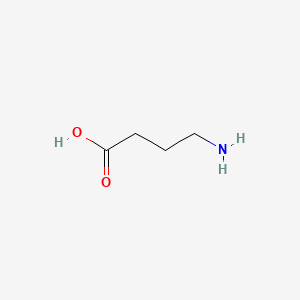| MeSH term | MeSH ID | Detail |
|---|---|---|
| Hemolysis | D006461 | 131 associated lipids |
| Uremia | D014511 | 33 associated lipids |
| Stomach Ulcer | D013276 | 75 associated lipids |
| Kidney Failure, Chronic | D007676 | 51 associated lipids |
| Sarcoma, Experimental | D012513 | 13 associated lipids |
| Arrhythmias, Cardiac | D001145 | 42 associated lipids |
| Adenocarcinoma | D000230 | 166 associated lipids |
| Pain | D010146 | 64 associated lipids |
| Autoimmune Diseases | D001327 | 27 associated lipids |
| Acidosis, Lactic | D000140 | 8 associated lipids |
4-aminobutyric acid
4-aminobutyric acid is a lipid of Fatty Acyls (FA) class. 4-aminobutyric acid is associated with abnormalities such as Epilepsy and Premenstrual syndrome. The involved functions are known as Binding (Molecular Function), neuron survival, Process, Uptake and physiological aspects. 4-aminobutyric acid often locates in Microglial, Neurofilament, Neuraxis, Brain region and Neurites. The associated genes with 4-aminobutyric acid are arginine methyl ester, SLC33A1 gene, NKS1 gene, P4HTM gene and ITSN2 gene. The related lipids are pregnenolone sulfate, pregnane-20-one, Pregnanes, Steroids and endogenous steroids.
Cross Reference
Introduction
To understand associated biological information of 4-aminobutyric acid, we collected biological information of abnormalities, associated pathways, cellular/molecular locations, biological functions, related genes/proteins, lipids and common seen animal/experimental models with organized paragraphs from literatures.
What diseases are associated with 4-aminobutyric acid?
4-aminobutyric acid is suspected in Premenstrual syndrome, Epilepsy and other diseases in descending order of the highest number of associated sentences.
Related references are mostly published in these journals:
| Disease | Cross reference | Weighted score | Related literature |
|---|
Possible diseases from mapped MeSH terms on references
We collected disease MeSH terms mapped to the references associated with 4-aminobutyric acid
PubChem Associated disorders and diseases
What pathways are associated with 4-aminobutyric acid
There are no associated biomedical information in the current reference collection.
PubChem Biomolecular Interactions and Pathways
Link to PubChem Biomolecular Interactions and PathwaysWhat cellular locations are associated with 4-aminobutyric acid?
Visualization in cellular structure
Associated locations are in red color. Not associated locations are in black.
Related references are published most in these journals:
| Location | Cross reference | Weighted score | Related literatures |
|---|
What functions are associated with 4-aminobutyric acid?
Related references are published most in these journals:
| Function | Cross reference | Weighted score | Related literatures |
|---|
What lipids are associated with 4-aminobutyric acid?
Related references are published most in these journals:
| Lipid concept | Cross reference | Weighted score | Related literatures |
|---|
What genes are associated with 4-aminobutyric acid?
Related references are published most in these journals:
| Gene | Cross reference | Weighted score | Related literatures |
|---|
What common seen animal models are associated with 4-aminobutyric acid?
There are no associated biomedical information in the current reference collection.
NCBI Entrez Crosslinks
All references with 4-aminobutyric acid
Download all related citations| Authors | Title | Published | Journal | PubMed Link |
|---|---|---|---|---|
| Vasil'ev VIu et al. | [Interaction of 4-aminobutyrate-transaminase from swine kidneys with 5'- and 6'-methyl derivatives of pyridoxal-5'-phosphate]. | 1976 | Biokhimiia | pmid:999979 |
| Faletti AG et al. | beta-Endorphin blocks luteinizing hormone-releasing hormone release by inhibiting the nitricoxidergic pathway controlling its release. | 1999 | Proc. Natl. Acad. Sci. U.S.A. | pmid:9990091 |
| Bravin M et al. | Control of spine formation by electrical activity in the adult rat cerebellum. | 1999 | Proc. Natl. Acad. Sci. U.S.A. | pmid:9990088 |
| Kash SF et al. | Increased anxiety and altered responses to anxiolytics in mice deficient in the 65-kDa isoform of glutamic acid decarboxylase. | 1999 | Proc. Natl. Acad. Sci. U.S.A. | pmid:9990087 |
| Maguire G | Rapid desensitization converts prolonged glutamate release into a transient EPSC at ribbon synapses between retinal bipolar and amacrine cells. | 1999 | Eur. J. Neurosci. | pmid:9987038 |
| Lu YF et al. | Enhanced synaptic transmission and reduced threshold for LTP induction in fyn-transgenic mice. | 1999 | Eur. J. Neurosci. | pmid:9987012 |
| Enz R and Cutting GR | GABAC receptor rho subunits are heterogeneously expressed in the human CNS and form homo- and heterooligomers with distinct physical properties. | 1999 | Eur. J. Neurosci. | pmid:9987010 |
| Nitsch C | Antivitamin B6 induced ultrastructural changes in the hippocampus of the convulsant rabbit and its biochemical correlates. | 1976 | Acta Neurochir (Wien) | pmid:998335 |
| Kim SS et al. | Focal lesion in the splenium of the corpus callosum in epileptic patients: antiepileptic drug toxicity? | 1999 | AJNR Am J Neuroradiol | pmid:9974067 |
| Ayala-Grosso CA and Urbina-Paez R | Septohippocampal adaptive GABAergic responses by AF64A treatment. | 1999 | J. Neurosci. Res. | pmid:9972820 |
